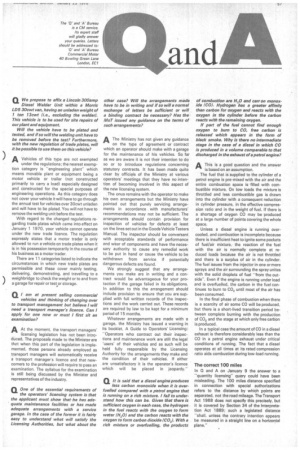Ct It is said that a diesel engine produces less carbon
Page 59

If you've noticed an error in this article please click here to report it so we can fix it.
monoxide when it is overfuelled compared with a petrol engine that is running on a rich mixture. I fail to understand how this can be. Given that there is sufficient oxygen in each case, the hydrogen in the fuel reacts with the oxygen to form water (H20) and the carbon reacts with the oxygen to form carbon dioxide (CO2). With a rich mixture or overfuelling, the products of combustion are H20 and carr on monoxide (CO). Hydrogen has a greater affinity than carbon for oxygen and reacts with the oxygen in the cylinder before the carbon reacts with the remaining oxygen.
If part of the fuel cannot find enough oxygen to burn to CO, free carbon is released which appears in the form of black smoke. Why is there no intermediate stage in the case of a diesel in which CO is produced in a volume comparable to that discharged in the exhaust of a petrol engine?
AThis is a good question and the answer is based on an assumption.
The fuel that is supplied to the cylinder of a petrol engine is pre-mixed with the air and the entire combustion space is filled with combustible mixture. On low loads the mixture is throttled and less combustible gas is drawn into the cylinder with a consequent reduction in cylinder pressure, in the effective compression ratio and in the weight of fuel. If there is a shortage of oxygen CO may be produced at a large number of points covering the whole space.
Unless a diesel engine is running overcooled, and combustion is incomplete because there is insufficient heat to ignite some pockets of fuel/air mixture, the reaction of the fuel with the air is normally complete at reduced loads because the air is not throttled and there is a surplus of air in the cylinder. The fuel issues from the injector in one or more sprays and the air surrounding the spray unites with the solid droplets of fuel -from the outside". Even if the engine is running under load and is overfuelled, the carbon in the fuel continues to burn to CO2 until most of the air has been consumed.
In the final phase of combustion when there is a scarcity of air some CO will be produced, but there is a short-lived transition period between complete burning with the production of CO2 and the stage at which only free carbon is produced.
In a typical case the amount of CO in a diesel exhaust is therefore considerably less than the CO in a petrol engine exhaust under critical conditions of running. The fact that a diesel operates at all times at its rated compression ratio aids combustion during low-load running.
The correct 100 miles In 0 and A on January 9 the answer to a "quantity licensing" query could have been misleading. The 100 miles distance specified in connection with special authorizations refers to the distance by which points are separated. not the road mileage. The Transport Act 1968 does not specify this precisely, but it is covered by Section 34 of the Interpretation Act 1889: such a legislated distance "shall, unless the contrary intention appears be measured in a straight line on a horizontal plane."








































































































